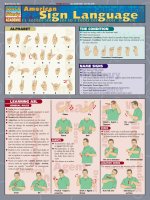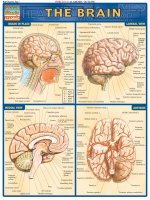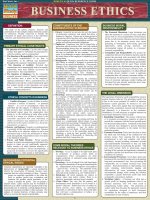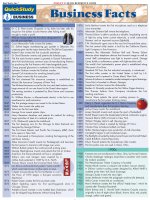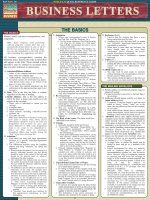BarCharts quickstudy coaching and mentoring
Bạn đang xem bản rút gọn của tài liệu. Xem và tải ngay bản đầy đủ của tài liệu tại đây (3.55 MB, 4 trang )
BarCharts, Inc.®
WHY HAVE A COACHING/
MENTORING PROGRAM?
Solves many contemporary work force issues:
• Helps businesses retain the best employees
• Eases communication breakdowns due to mergers and acquisitions
• Develops leaders who can deal effectively with
the information age
• Recent hirees can develop profiles of success by
learning from others with more experience and
knowledge
• Provides a method to coach executives
What mentors/coaches can do
• Give participants (protégées or mentees) knowledge, skills and insights offered by someone
with greater experience
• Introduce career-related activities to enhance skills
• Relate personal experiences that teach a lesson
• Give access to other leaders in the field
• Share knowledge of emerging trends
• Introduce new behaviors that relate to specific
needs within the organization
Who’s doing it?
• 97% of corporations use coaching and mentoring, at least informally
• 66% have formal executive mentoring programs
• 38% have formal executive coaching programs
COACHING VS. MENTORING
Both methods focus on helping others reach
goals, share problems, seek solutions, and engender self or professional improvement.
• Coaching is a formal, personalized
approach for individuals to assess specific
or problem areas of their careers, their lives
and/or their needs. It is a paid position if an
external consultant is used and includes
specific actions and goals.
• Mentoring is an unpaid, informal relationship,
often by a role model. It may be a one-time
meeting or intermittent, depending on needs.
360 DEGREE ASSESSMENTS
• Multi-rater’s tool used for leadership coaching of
an individual or an entire management team
• Rapidly gaining favor to define development
needs of an entire organization; helps to identify
already present skills and behaviors as well.
• Important to have a skilled coach involved in this
process to avoid divisiveness and finger pointing;
climate of trust is necessary to build competencies
• Accurately focuses on developmental needs of individuals with confidential and anonymous feedback
• Assesses perceptions of other stakeholders in the
organization, i.e., peers, direct reports and supervisors, as well as one’s own strengths and weaknesses
• Is non-judgmental and can be Web based
• Measures competencies and behaviors demanded by the organization; can include more than
100 specific leadership behaviors
• Results are collated into one report from all
respondents to determine appropriate actions
and strategies
• Assessments and prices differ from publisher to publisher; coaches usually have preferences for using the one that they are most
familiar with
• Can be used for entire management teams
and multi-departments to increase leadership skills
• Can be re-administered over time to measure
and track ongoing observable behavior, and provide ongoing feedback
WORLD’S #1 QUICK REFERENCE GUIDE
HOW ARE THE PROGRAMS
STRUCTURED?
There are as many models and design structures
to coaching and mentoring programs as corporations researched. The most successful results
have the following in common:
• Use of a comprehensive approach to leadership development
• Use of coaching and mentoring as one component
• Driven by strong CEO business initiatives
• Begin with clearly defined goals, objectives,
and measurements
• The most effective coaches are external consultants rather than current staff, but mentors
are internal or external
• Build strength within organizations
BASICS OF COACHING/
MENTORING PROGRAMS
• Mentoring is a recognized workplace practice
that establishes personal contact and interaction between management and staff.
• Mentoring programs became more formal when
well documented research proved that a personal
interest in someone is an appropriate intervention to combat a faceless technological and global business world.
• The terms, “mentoring and coaching,” are often
used without discrimination, but they do differ
in style and in substance (see Coaching vs.
Mentoring).
• Whether one enters a coaching or mentoring
relationship, it is important there be a commitment from both persons.
• Providers and recipients must be able to communicate with one another and agree upon setting
goals and learning new behaviors. The goal must
involve the advancement of the mentee.
• Disciplining employees has no part in either
mentoring or coaching programs because these
sessions or meetings are separate from performance reviews.
• Completing a coaching or mentoring program
may be part of the performance expectations
developed during review sessions.
• Participants who serve in either role must be
willing to consider “out of the box” ideas to promote outcomes of leadership skills and superior
work habits.
• Two Main Categories
- Highly structured, short-term:
º Established for introductory planning or
for a short period to meet a need within the
organization (such as employee orientation)
º To prepare someone to take over for a
vacated or newly created position
- Highly structured, long-term:
º Established for secession training
º Preparation for leadership roles as a career
path and part of a career ladder program
MENTORING AND COACHING
AS AN ORGANIZATIONAL AND
CORPORATE SOLUTION
Mentoring is successful when it meets one or more
of the following key needs:
• Provides a support system for new staff, introduces them to company culture, and provides role
models; often improves staff retention rates
• Eliminates need to go outside the company for
new hires; allows easy identification of skills and
abilities, as well as those with leadership potential
• Gives management the tools to identify appropriate candidates for fast tracking
• Supports diversity in the workforce; minorities and
under-represented groups benefit professionally
and personally
• Develops and motivates those employees who
are isolated from the company culture due to
technology needs, working off site or at home
• Provides incentives to individuals to accelerate
learning and goal attainment
• Reduces stress and burnout; provides a challenge or an appropriate time out
• Supports continuous learning in changing business climates and environments
FINDING THE RIGHT PEOPLE
FOR THE JOB
The mentor/coach:
• Has a long lasting effect on another person
• Gives others knowledge, insight or perspective
• Encourages exploration of ideas
• Listens to complaints and offers assistance in
identifying and solving problems
• Provides appropriate training and counseling
• Encourages appropriate risk taking
• Provides opportunities for new contextual beliefs
• Has a high degree of knowledge and experience
in their field
• Is able to exert influence on behalf of participant
• Does not attempt to make participants adopt uncomfortable roles or challenge their value systems
Selecting mentors/coaches:
• Appoint an internal committee or external consultant to determine objective selection criteria
• Committee can direct the program as it selects
and pairs mentors/coaches with participants
• Selection aide – some questions to help select
the right coaches/mentors:
- What are the personal strengths of the
coach/mentor?
- How well does the mentor/coach communicate?
- How does the mentor/coach approach issues
and make decisions?
- How does the mentor/coach react under stress
or when challenged?
- What interaction style, belief systems, and
assumptions will each person bring to an
interaction?
CAVEATS
When hiring a coach or working with a mentor:
• Coaches and mentors are not created equal and
many persons have jumped on the bandwagon to
provide coaching or become involved in mentoring programs to promote themselves in the company’s eyes.
• Be a wise consumer or staff member. Make certain the person you hire or who has been assigned
to you is willing to address your expectations, can
explain how they diagnose problems and be creative in offering solutions.
1
• Coaches should also exhibit good listening skills,
have an understanding of your business and your
industry, not waste time in scheduled sessions, and
be accessible to you when you need them.
• If, anytime during the coaching process, any of
these things cease to exist, then it may be time to
question the relationship or terminate the
coaching program with that person and seek
out someone more compatible.
• Keep in mind, coaching and mentoring
programs are to help individuals learn
and succeed in the business world.
SETTING UP
PROGRAMS
FORMAL TRAINING NEEDED
Companies need formal training programs for
mentors/coaches to ensure consistent relationships and understanding of roles and competencies required. Evaluations take place during and
at conclusion of formal programs.
• Develop resources for formal mentoring programs
- Search the internet for resources on mentoring
topics
- Library of written materials should be readily
available
- A trained research librarian should be able to
help you find what you need
• Recruit mentors/coaches
- Schedule information session for qualified
persons
- Announce program: goals, objectives, time
commitment and expectations
- Discuss benefits to mentors/coaches; what
will they get out of participating and the value
of the program to organization
• Communication skills and counseling training
for the mentor involves evaluating needs
assessment and developing related activities
- Role-playing will help determine how communication skills work in different situations
and help develop listening skills, as well as
teaching how to ask appropriate questions
- Setting goals that help people grow should be
the main focus
- Skill building: Practice sessions and activities
encourage and motivate participants
- Must work at establishing trust and building
rapport
- Conflict resolution techniques crucial- where
there is growth there will always be at least a
little conflict
- There must be a method to determine issues
of confidentiality (see QuickStudy® Guide,
Managerial Skills)
- There must be a set evaluation/ “accountability strategy”
- Sample questions for beginning mentoring
discussions
º Keeping in mind the goal of the discussion,
ask, “What activity are you presently working on?” (May be about a new project; about
employees normal work routine, i.e., customer service)
º What do you hope to accomplish on a short
or long term basis?
º Are you completing a project goal (a finished design) or a performance goal (communication skills)?
º How can I or others assist you?
• Participant orientation session topics
- Explain program goals and objectives as
defined by company needs
- Discussion of the roles and expectations of
all participants
- Importance of scheduling and meeting with
participants
• Training curriculum should include the
teaching of coaching skills
- Styles of coaching differ as do learning styles;
use assessments to identify communication
and learning style
- Some assessments (e.g. Myers Briggs/Firo B,
Consulting Psychologist Press) will identify
communication styles, needs, developmental
issues and suggest action plans; these assessments serve to take the issues into an objective
mode
COACHING FOR
PERFORMANCE IMPROVEMENT
ADDITIONAL CONSIDERATIONS
When setting up programs and selecting participants, the focus should be on meeting the needs
of the organizational structure as well as those of
the participants.
• Informal mentoring and coaching roles can take
the place of, or coexist with, formal programs
- Informal supporters are peers or management who often have no formal role but provide emotional and psychological support that
ultimately keeps employees motivated
- Role models have skills and expertise or hold a
position that employees may be aiming for; there
can be multiple role models for any one person
- When an individual agrees to serve as a
coach or a mentor in a formal or informal
role they must:
• Be able to communicate effectively with others
• Be willing to spend the time and effort to assist
another individual to succeed
• Be willing to consider “out of the box” ideas to
ensure leadership skills and superior work habits
are result
Coaching for performance improvement is often
necessary and differs from other coaching.
Coaching in this instance is based upon reviews
and or reports of poor behavior or inappropriate
skill levels that can lead to termination. In
this model, coaching is tied to performance
reviews and carries consequences beyond
an individual’s desire to change. The immediate supervisor often provides the coaching, but
it can be carried out by an independent coach.
Identify unsatisfactory
performance
yes
Is it essential to employee
to change in some way?
no
It may be a one time reaction or a value judgment not
essential to performance
no
Let employee know;
provide feedback
no
Let employee know;
determine if a coach or a
mentoring program would
benefit the person and if
they are willing to become
involved
yes
Does employee know performance is unsatisfactory?
yes
Does employee know
what is supposed to be
done and when?
SETTING GOALS
• The mentor/mentee relationship must be based
on meeting specific goals, rather than on the
development of a friendship or sporadic counseling relationship.
• If is often effective to hire external consultants
to set up these goals, as the success of the entire
program is dependent on them.
• What should the goals be?
- Goals should meet the SMART goals criteria;
Specific, Measurable, Attainable, Realistic
and Time sequenced
- Goals should fit into company plans
- Must be written to gain support from others
within department or organization and be
aligned to organization’s goals or strategic plans
• Developing Contracts
- Must take into consideration others involved
in goal or project
- Include actions that must be taken to reach
this goal
- Include strategies for overcoming obstacles
that would impede progress
- Involve options and alternatives to be considered as plan progresses
- Include a statement of commitment
yes
Are there obstacles
beyond the employee’s
control?
yes
yes It may be a one time reaction or a value judgement
not essential to performance
Does employee know
how to do it?
no
Provide training and set
goals; provide practice
yes
Does negative consequence
follow performance?
no
Does positive consequence
follow performance?
yes Consult with mentor or
coach for appropriate consequences; redirect
employee’s behavior
no
Provide rewards
no
Repeat consequences for
non-performance and have
coach or mentor reinforce
final consequences
yes
Could employee do it if he
or she wanted to?
yes
Transfer or termination
COACH/MENTOR AND PROGRAM
EVALUATION CRITERIA
• On regular, predetermined intervals, review
coach/mentor effectiveness and participant
growth through surveys and random interviews.
Routinely gather data from participants.
• Schedule evaluations for improvement of organizational communication, retention rates,
work/life balance satisfaction, and career guidance of all participants. There are many effective
human resources tools available to complete this
part of the process.
Sample Development Plan to Track Progress
• Putting it in writing makes it easier for everyone
to agree on the plan and to evaluate progress of
participants in a coaching or mentoring program.
• There are many forms for doing this, however, it
should be kept simple and easy for participants at
all levels to understand if they are to buy into
these programs as a way to develop themselves.
• Programs should never be seen as mandatory,
but, rather as an opportunity to be involved in a
professional development program.
Individual Development Plan
Employee Name:______________________
Present Position: _____________________________Date Assigned Present Position: ____________
Development Goals
Needed Skills
1.
2.
3.
4.
5.
6.
Employee Comments:
Mentor Comments:
Consultant Comments:
2
Recommended Plan of Action
Est.Completion Date
MENTEE BENEFITS
How mentees can benefit most by coaching from
manager.
• Help the coach or mentor by asking for clarification, and giving feedback if there is a question
or disagreement about anything being suggested.
• Accept responsibility for yourself. Either
the mentor or the coach can initiate coaching sessions. If they feel a need to meet
with the coach outside regularly scheduled
sessions, they should ask.
• Respond positively to the coach’s feedback,
advice and factual information, and seek to
receive understanding and support.
• Be realistic and avoid being defensive. They should
not expect goals to be given a higher priority than
those of the company; they should be in alignment.
• Seek steady progress. Focus on shorter range
milestones instead of forcing themselves to take
gigantic leaps towards agreed upon goals.
POSITIVE COACHING VS.
PROBLEM SOLVING COACHING
Coaching takes on many formats and can be
used as a continuous supportive program or
when specific performance problems require
immediate attention.
Positive Coaching
Problem Solving Coaching
Purpose:
Review strengths or
opportunities
A meeting to develop a performance improvement plan
for growth and enrichment
Goals:
Improve motivation, Behavior change, corrections,
and adjustments
growth in organization
Time Focus:
Future
The present - what is happening right now
Role of Coach:
To assess and
support person’s
needs and manage the
problem solving
Improving current situation
process; results in
effort put forth relative
to organizational needs
and the encouragement
of risk taking for
greater contributions
EXECUTIVE
COACHING
EXECUTIVE OR PERSONAL
COACHING
Executive coaching is a benefit to senior level
management. While mentoring and coaching can
be used at any level of the organization, Executive
Coaching is becoming more of an integral
necessity for executives in leadership roles.
• Coaching often relieves the “loneliness at the
top,” when CEO’s and their counterparts deal
with the complex issues resulting from their
decisions and actions.
• Egos, ethics, and perceptions that ultimately
influence the stakeholders and shareholders of a
company require the introspection that executive coaching can bring.
• Executive coaches in corporate life can
address needs in leadership development,
speech delivery, business etiquette, people
skills, management or even appearance. It
may be necessary to have coaches who specialize in these different elements.
WHY SENIOR EXECUTIVES HIRE
EXTERNAL COACHES
• To observe their performance and give feedback
- Impartial feedback is less threatening from an
external coach
• Time and attention of the coach is devoted solely to learning and gaining new knowledge about
the mentee and the impact of the behavioral
changes on others
• Coaches must have appropriate business background, be experienced in coaching skills and be
able to administer appropriate assessment tools
• Coach certification guarantees a specific level
of competence
WHAT THE EXECUTIVE COACH
CAN TEACH
Coaching partnerships involve sharing the
leader’s vision of the organization with employees.
Research supports increase of employee loyalty
to company.
• How to deal with the stress of the changing
environments within the workplace
• How leaders become helpers, not supervising
critics
• To avoid confrontation and focus on teamwork
and positive reinforcement
• To overcome internal barriers and discover
new opportunities
• More effective communication
• Management of sensitive issues relating to business relationships
• To create credibility in presentations
• To strengthen stress management and coping
skills
• To manage time productively
• To develop a personal and effective leadership
style
• To create guidelines for moving up the ladder
• To develop and maintain a consistent professional image
• To create authority and credibility in a professional image
• To develop skills for delegating with authority
• How to deal with issues of self esteem, personal and professional confidence
CONCEPTS OF COACHING FOR
LEADERSHIP COMPETENCIES
Senior managers and executives in organizations who want to be consistently upward bound
rely on professional coaching to be certain they
are effective leaders. They understand the benefits of having a coach in the same way a sports
hero continues to be coached even when he or
she has risen to the top of their field.
• Old-line thinking and executive management
can be a block to dealing with pressures of managing organizations. New competencies are
needed to be successful. The global economy
and changing economic systems require new
Leadership Competencies (Scholtes)
• These include:
- Learning to think in terms of leadership of
systems; understanding the variety of work,
planning and problem solving
- Understanding how people learn, develop and
improve
- Providing leadership in real learning and systems improvement
- Understanding human behavior and cultural
differences
- Understanding interdependence and interaction between systems, variation, learning and
human behavior; knowing the effects on one
another
- Providing vision, meaning, direction and
focus to the organization
3
IMPROVES EFFICIENCY
Coaching improves performance and enhances
efficiency of staff members.
• Creates less need for constant supervision
• Focuses on and brings out employee potential
• Increases job satisfaction
• Provides mutual support
• Lessens stress
• Allows for empowerment
• Provides methods for problem solving
• Teaches balancing of life skills
• Creates authority and credibility in a professional
image
• Develops consistency
• Deals with self-esteem issues and personal and
professional confidence
• Deals with difficult people successfully
• Identifies problems that interfere with professional success
• Provides career development
• Creates ongoing feedback
• Allows for incentives for goal setting
• Develops conflict resolution skills
• Focuses on teamwork and positive reinforcement
IMPROVES EFFECTIVENESS
All management becomes more effective when
executive coaching programs are in place.
• Executives allow for delegation of routine
tasks to managers and supervisors
• Problem solving and planning for the future
takes place at all levels so there is ready buy-in
• Managers and supervisors are encouraged to
become proactive instead of reactive
• Teaches conflict resolution by involving open
discussion and free exchange of ideas at all
levels
• Learning to value every employee increases
productivity and as a result a return on the
investment in human capital
• Provides feedback for ongoing projects for risk
management and reduction of costly errors
• Provides ongoing new ideas to increase efficiency
TRAINING VS. COACHING
Coaching skills are also used to train; however, it is
important to know the differences, when to train
and when to coach. This model differentiates the
two, relative to desired outcomes.
Training
Coaching
Imparts basic skills
Teaches skill application
Helps break old habits
Helps build new habits
Encourages/molds behaviors Sculpts/guides behaviors
Increases confidence
Challenges
Narrows range of freedom Broadens range of freedom
Requires close supervision
Decreasing supervision
Frequent feedback
Frequent feedback
Builds skills/knowledge
Builds results
COACHING SMALL GROUPS
THE COACH AS TEACHER/FACILITATOR:
Effective coaches model the behaviors they want
staff members to live by. The role of a coach is to
develop highly performing people and often
becomes that of an instructor. The process
includes the know-how to facilitate learning for
growth opportunities.
• Steps to the Instruction Process
- Understand adult learning
- Knowledge of instructional design and skills
for meaningful teaching
- Knowledge and skills to facilitate learning in
different ways and to use various techniques
• Consider using the following Four Step Process
by Mink, Owen, and Mink in Developing High
Performance People, The Art of Coaching:
- Telling: Explain to the participant exactly
what the task is, how it fits into the big picture
of the team or the company, how it is done and
how well it must be done to reach a satisfactory level of competency.
- Showing: Demonstrate how to perform the
skills, and explain the relevance of each task as
you proceed.
- Doing: Allow participant to actually perform
tasks after you have demonstrated them. As
they are doing so, ask questions that will
demonstrate their understanding. Learning by
doing is often favored by many.
- Correcting: Positive feedback is an appropriate
way to enhance learning. Coaches should provide feedback that allows errors to be immediately corrected before they become habit. Also
gives positive reinforcement while learning and
skill building are taking place. Builds selfesteem and confidence.
• To Become A Successful Coach One Must:
- Know how to develop a learning plan that
includes essential steps
- Know how to set up mutually agreed upon
learning goals for buy-in
- Define gaps between ambitions and current
situation
- Determine gaps between current situation and
life needs
- Include feelings and recognized desires or wants
- Cognitive component of a competency:
Involves acquisition of specific set of facts or
knowledge
- Affective component of a competency:
Involves a value component
- Behavioral component of competency:
Involves acquiring a set of behavioral skills
EFFECTIVE COMPETENCY
BUILDING
Tell the staff
person what he
is supposed to do
Show how it is
to be done
Make your
explanations clear
Demonstrate
each task step
by step
Show what you
tell
Explain the
work as you go
along
Point out spots
where mistakes
occur
Allow for
questions at any
time
Go at an
appropriate pace
Ask questions
Be clear in your
use of terms
Allow for
questions at any
time
Illustrate the
work using
media
Video
Sketches
Charts
Films,
interactive software, models
Allow for
questions at any
time
• Goal is to give staff opportunity for practice and
experience in performing skills that demonstrate
competency.
• Final mode of coaching is counseling to enable
associates to consciously make changes in behavior.
CULTURAL
COMMUNICATION
CULTURAL COMMUNICATION
IN COACHING
See also QuickStudy® guide “Managerial Skills.”
• Impact of styles across cultures is as different as
their languages, even when using the same language to communicate
• Essential for good managers to understand cross
cultural communications to eliminate confusion,
blunders, lost confidence and opportunities to
succeed as a coach or mentor
• Learn to expect and identify cultural differences
• Draw cues from non-verbal communication
• Be careful of humor
• Examine your own cultural conditioning
• Review cultural experiences from the past
• Identify any prejudices and biases that you may have
• Identify your own cultural discomfort zones
• Modify your style and expectations to match
cultural differences
CULTURAL CASE STUDY
Li will not look Gayle in the eye during their coaching sessions. He does not adhere to deadlines. Gayle
feels that he is unorganized, evasive and disrespectful
of her as a manager.
Li’s cultural background dictates that he not look a
“superior” directly in the eye and that deadlines are not
a firm commitment unless agreed to.
In actuality, there is a cultural difference that needs
to be addressed openly and in a trusting manner.
Differences are not bad, inferior or wrong.
Gayle had some biases and stereotypes to overcome.
The entire coaching process will deteriorate and be
unprofitable without getting training for both the manager and the employee in cultural expectations and
how to cross cultural barriers.
COACHING AND
CULTURAL CAVEATS
When coaching
Aggressive attitudes don’t
individuals from a
work; tact and diplomacy
different culture, never
are a must
be aggressive
Set time related goals
that are realistic to the
cultural preceptions
Time differs with each
culture
Make certain the coach
Coaching may be seen as fully understands that the
a reprimand by certain
purpose is performance
cultures
improvement
COACHING ACROSS
CULTURAL DIMENSIONS
Cultural understanding requires special knowledge
of a coach. The Three C’s (from the Center for
Creative Leadership, Greensborough, NC) are
three basic rules used to access better cross cultural
communications.
• Capture: Focus intently on the conversation.
Capture what is said and refer back to your own
knowledge of other cultures to discover meaning
before speaking.
• Clarify: Look for non-verbal cues and/or ask
questions.
• Confirm: Paraphrase and clarify your responses as well as speaker’s points. Write down message to share for understanding or schedule a
follow-up meeting.
4
CROSS-CULTURAL TIPS
Tips to avoid insensitivity to cultural differences
when coaching and mentoring.
Examples of behavior to watch for and to immediately change. It not only destroys the trust that
must be present in a mentoring or coaching
relationship; but may be grounds for dismissal or even litigation.
• Off-color humor: Jokes and attempts at
humor that may be construed as sexual in nature
or make fun of a certain race, ethnicity, religion,
sexual orientation or disability.
• Ridiculing or insulting remarks: Any innuendos or poking fun that personally attacks another person or persons. Even subtle comments can
and do anger or hurt those on the receiving end.
• Profanity and vulgarity: The use of profane,
vulgar or lewd language. Since it is highly
unprofessional under any circumstances, such
language should be strictly controlled when in
the workplace.
• Stereotypical remarks: Broad generalizations
of a subtle but degrading nature about groups of
people. Comments that start out as, "Those kind
of people are all like this," or "I'm not prejudiced, but… " are usually stereotypical remarks
that cross the line of respect.
• Subtle-to-overt sabotage: Withholding information, not giving help that people need to do their
jobs, or deliberately presenting information in
such a way that the person cannot understand it.
• Threats or slurs: Intimidation about someone's
job situation or threats aimed at someone's physical safety, derogatory name-calling; commonly
aimed at race, ethnicity, gender, religion, and
sexual orientation.
• Mimicking: Ridicule that usually involves
imitating another person's accent.
• Exclusion: Leaving someone out from the
work group that will isolate the person and
consequently influence productivity.
NOTE: This QuickStudy® chart is an outline
of basic principles of Coaching and
Mentoring. Due to its condensed nature, we
recommend you use it as a guide, but not as a
replacement for expert, in-depth advice.
Customer Hotline # 1.800.230.9522
Author: Toby Berger, IAOP, Human
Resources/ Organizational Development
Consultant
US $4.95
CAN $7.50
October 2007
All rights reserved. No part of this publication may be reproduced or transmitted in any form, or by any
means, electronic or mechanical, including photocopy, recording, or any information storage and retrieval system, without written permission from the publisher. ©2003 BarCharts, Inc.
ISBN-13: 978-142320434-3
ISBN-10: 142320434-4
hundreds of titles at
quickstudy.com



